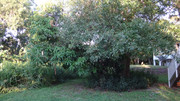976
Tropical Fruit Discussion / Re: Do worms eat rice?
« on: September 08, 2019, 05:38:08 PM »
When he added brown rice it got moldy and was removed- day 60. I am planning a large worm farm as my main fertility source.
Email features have been reactivated 4/17/24
This section allows you to view all posts made by this member. Note that you can only see posts made in areas you currently have access to.
I think I would be more worried that it won't get enough sun.Yes, but it depends on the orientation of the house and resulting shade.

I knew they would lean outwards.
These nanas have started to get pretty big since I first stared this thread and are starting to lean a bit.
Does anyone have a suggestion or idea on how to anchor them to the cinderblock wall? Thanks.
Here’s the progress so far:These photo say I need permission to see. Maybe you need to set them to public?
https://drive.google.com/file/d/127fWj7SInjN6TJshswIBzGr2BCuitNhS/view?usp=drivesdk
https://drive.google.com/file/d/1hZ0560SIaoN5IGDQvyMmqoVs-MUE4Ya4/view?usp=drivesdk
https://drive.google.com/file/d/1GcSTDlhigRwnOVZQbQcKAZJZygga_Ggc/view?usp=drivesdk


What would be the best way to combine these 4 species mono cropping patches within the food forest?There are advantages to keeping similar trees together, but maybe advantages to spreading them out.
Could I intercrop between them (for example macadamia and coffee), and with other species (such as bananas, etc)? What would be the best tree spacing for these crops? Any suggested varieties for these species?
i still think your calculations in hectares are wrong and the fires in Brasil are probably 4-5 times bigger.My calculations are accurate, and based on the figures quoted in the newspaper, there is a big difference in the case of Bolvia.
Evo Morales legalized agrarian burninghttps://translate.google.com/translate?hl=en&sl=es&u=https://es.panampost.com/mamela-fiallo/2019/08/25/incendio-bolsonaro-evo/&prev=search
A month before the fires, on July 9, Bolivian President Evo Morales approved the modification of the “Supreme Decree (DS) 26075” through the promulgation of DS 3973, which allows burning of permanent forest production lands.
Scientists' view - https://www.sciencemag.org/news/2019/08/theres-no-doubt-brazils-fires-are-caused-deforestation-scientists-sayYour link says:
Recent data have clearly shown that deforestation in Brazil is on the rise. From January through the end of July, 6800 square kilometers were cleared, according to INPE, 50% more than in the same period last year.
"A team of University of Florida biologists found, for example, that it was almost impossible to establish the Brazilian pepper in an undisturbed forest."That was believed true in 1982 by the New York Times.
Humans have damaged the landscape so much.

And there is another aspect when calling socialist vs capitalists.The socialists did manny mistakes ,but they have the power to revert them back as you see in China right now,whereas the capitalists take the monney,destroy the land and they cant do nothing to restore it after because there is no profit in doing so.Actually, since forests produce wood which is a renewable resource they are quite profitable and are increasing in the USA, which did significantly deforest and is a capitalist country. My family has operated a sustainable timber farm in Arkansas for over 100 years and 4 generations

